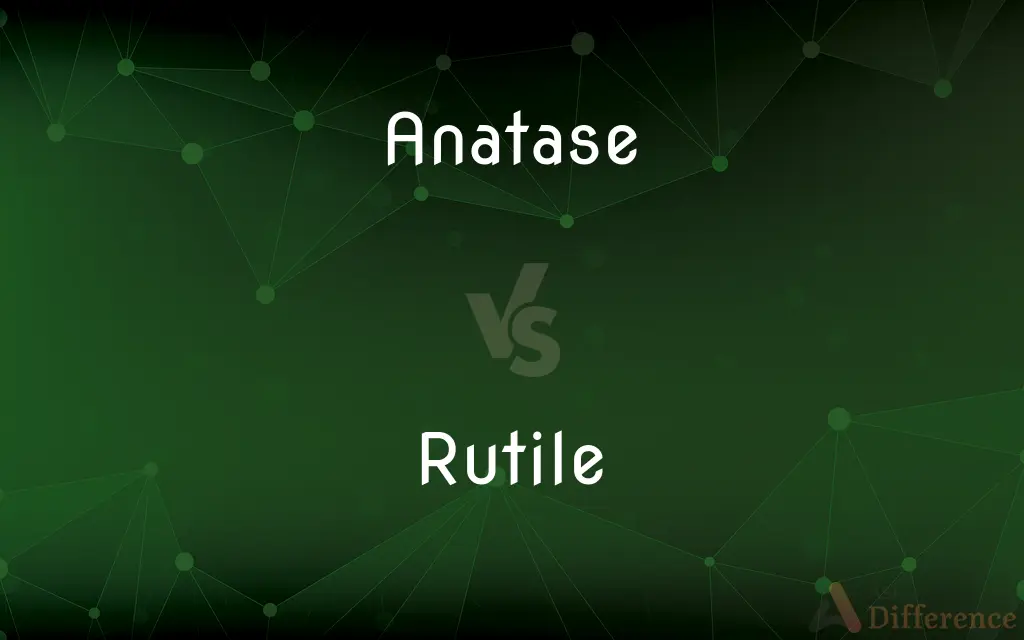Anatase vs. Rutile — What's the Difference?
By Fiza Rafique & Maham Liaqat — Updated on February 28, 2024
Anatase and rutile are both polymorphs of titanium dioxide (TiO2), with anatase being less dense and having a higher surface area, while rutile is more stable and dense.

Difference Between Anatase and Rutile
Table of Contents
ADVERTISEMENT
Key Differences
Anatase and rutile are crystalline forms of titanium dioxide, differing primarily in structure and physical properties. Anatase has a tetragonal structure, making it less dense and providing a higher surface area, beneficial for photocatalytic activities. Rutile, with its more compact tetragonal structure, is denser and considered thermodynamically more stable than anatase.
The photocatalytic efficiency of anatase is higher than that of rutile, making anatase preferred for applications requiring photocatalysis, such as in self-cleaning surfaces and pollution control. Rutile, however, due to its stability and optical properties, is often used in pigments and in the production of refractory ceramic materials.
In terms of optical properties, anatase scatters light more effectively, which is why it's used in sunscreens and paints to provide transparency and UV protection. Rutile, with its higher refractive index, is favored for producing white pigments that are widely used in paints, plastics, and papers.
Anatase transforms to rutile at high temperatures, a process that can be influenced by impurities, particle size, and the presence of specific catalysts. This transformation is crucial in the synthesis of materials that require specific crystal structures for their application.
The choice between anatase and rutile depends on the application's requirements: anatase for activities requiring high surface area and photocatalytic action, and rutile for those needing material stability, high refractive index, and density.
ADVERTISEMENT
Comparison Chart
Crystal Structure
Tetragonal, less dense
Tetragonal, denser
Surface Area
Higher
Lower
Stability
Less stable thermodynamically
More stable thermodynamically
Photocatalytic Activity
Higher
Lower
Applications
Photocatalysis, sunscreens, paints
Pigments, refractory materials
Optical Properties
Better light scattering
Higher refractive index
Transformation
Transforms to rutile at high temperatures
Does not transform
Compare with Definitions
Anatase
Preferred for applications requiring light scattering.
Anatase is incorporated into sunscreens for effective UV protection.
Rutile
A stable and dense tetragonal form of titanium dioxide, widely used as a pigment.
Rutile is the primary form used in white paints for its opacity.
Anatase
A tetragonal crystalline form of titanium dioxide with high photocatalytic activity.
Anatase is used in self-cleaning windows due to its photocatalytic properties.
Rutile
More thermodynamically stable than anatase, preferred for high-temperature applications.
Rutile is utilized in refractory ceramics for its thermal stability.
Anatase
Less dense with a higher surface area, enhancing its reactivity.
Anatase coatings are applied on surfaces for air-purifying purposes.
Rutile
Its optical properties are exploited in the production of white pigments and coatings.
Due to its refractive index, rutile enhances the brightness and opacity of products.
Anatase
Used in paints for its ability to provide transparency while blocking UV light.
Anatase titanium dioxide is added to paints to improve color and durability.
Rutile
Does not transform at high temperatures, making it reliable in various industrial processes.
Rutile's stability is crucial for its use in pigment production.
Anatase
Transforms into rutile at high temperatures, affecting its use in thermal processes.
The anatase to rutile transformation is considered in the production of ceramics.
Rutile
Has a higher refractive index, making it valuable in optical applications.
Rutile is used in the manufacturing of optical components and sunscreen.
Anatase
Anatase is a metastable mineral form of titanium dioxide (TiO2). The mineral in natural forms is mostly encountered as a black solid, although the pure material is colorless or white.
Rutile
Rutile is a mineral composed primarily of titanium dioxide (TiO2), and is the most common natural form of TiO2. Other rarer polymorphs of TiO2 are known, including anatase, akaogiite, and brookite.
Anatase
A rare blue or light yellow to brown crystalline mineral, the rarest of three forms of titanium dioxide, TiO2, used as a pigment, especially in paint.
Rutile
A black or reddish-brown mineral consisting of titanium dioxide, typically occurring as needle-like crystals.
Anatase
(mineral) A blue or brown mineral, a form of titanium dioxide, used as a pigment.
Rutile
A mineral usually of a reddish brown color, and brilliant metallic adamantine luster, occurring in tetragonal crystals. In composition it is titanium dioxide, like octahedrite and brookite.
Rutile
A mineral consisting of titanium dioxide in crystalline form; occurs in metamorphic and plutonic rocks and is a major source of titanium
Common Curiosities
Can anatase transform into rutile?
Yes, anatase can transform into rutile at high temperatures, a process influenced by factors like particle size and the presence of impurities.
What are anatase and rutile?
Anatase and rutile are polymorphic forms of titanium dioxide, differing in crystal structure, stability, and photocatalytic activity.
How do anatase and rutile differ in structure?
Both have tetragonal crystal structures, but anatase is less dense with a higher surface area, while rutile is denser and more compact.
Which form of titanium dioxide is more photocatalytically active?
Anatase exhibits higher photocatalytic activity compared to rutile, making it more effective in applications like pollution control.
Why is rutile preferred in pigment production?
Due to its high refractive index and stability, rutile is favored for producing white pigments that offer superior coverage and brightness.
What applications benefit from the use of anatase?
Anatase is used in photocatalysis, sunscreens, and paints, benefiting from its high surface area and light scattering properties.
Why is rutile used in refractory materials?
Rutile's thermal stability makes it suitable for high-temperature applications, such as in refractory ceramics.
What makes rutile more thermodynamically stable than anatase?
Rutile's denser crystal structure contributes to its greater thermodynamic stability under various conditions, including high temperatures.
How do the optical properties of anatase and rutile differ?
Anatase scatters light more effectively, while rutile has a higher refractive index, influencing their use in optical applications and pigments.
What is the significance of the anatase to rutile transformation?
The transformation affects the material's properties and is considered in applications requiring specific thermal or physical characteristics.
Which form of titanium dioxide is used in sunscreens for UV protection?
Both forms are used, but anatase is preferred for its ability to scatter UV light effectively, while rutile is chosen for its high refractive index and stability.
Can the transition from anatase to rutile be controlled?
Yes, the transition can be controlled by adjusting the synthesis conditions, such as temperature, time, and the presence of dopants or impurities.
What role do anatase and rutile play in the paint industry?
They are used as pigments in paints; anatase for its light scattering and transparency, and rutile for its opacity and brightness.
How does the photocatalytic activity of anatase benefit environmental applications?
Its high photocatalytic efficiency is utilized in breaking down pollutants and harmful chemicals, aiding in air and water purification.
How do anatase and rutile impact the properties of sunscreens?
Their ability to block or scatter UV light makes them key ingredients in sunscreens, contributing to the protection against UV radiation.
Share Your Discovery

Previous Comparison
Pliant vs. Flexibility
Next Comparison
Favor vs. FavouriteAuthor Spotlight
Written by
Fiza RafiqueFiza Rafique is a skilled content writer at AskDifference.com, where she meticulously refines and enhances written pieces. Drawing from her vast editorial expertise, Fiza ensures clarity, accuracy, and precision in every article. Passionate about language, she continually seeks to elevate the quality of content for readers worldwide.
Co-written by
Maham Liaqat














































